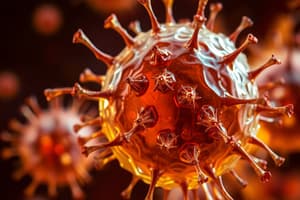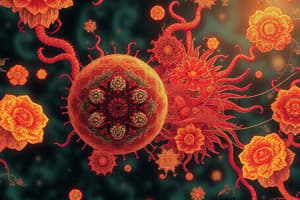Podcast
Questions and Answers
What is the primary function of Fas ligand in the immune system and cancer progression?
What is the primary function of Fas ligand in the immune system and cancer progression?
- Promoting cell proliferation and differentiation
- Regulating gene expression and transcription
- Activating the inflammatory response
- Inducing apoptosis through receptor binding (correct)
What is the main difference between the extrinsic and intrinsic apoptotic pathways?
What is the main difference between the extrinsic and intrinsic apoptotic pathways?
- One is exclusive to vertebrates, while the other is not
- One is mediated by caspases, while the other is not
- One involves the release of cytochrome c, while the other does not
- One is activated by death receptors, while the other is not (correct)
What is the role of BID in death receptor-mediated apoptosis?
What is the role of BID in death receptor-mediated apoptosis?
- Regulating gene expression and transcription
- Inhibiting the release of apoptogenic proteins
- Facilitating the release of cytochrome c from the mitochondria (correct)
- Activating the inflammatory response
What is the final outcome of both the extrinsic and intrinsic apoptotic pathways?
What is the final outcome of both the extrinsic and intrinsic apoptotic pathways?
What is the primary function of APAF-1 in the intrinsic apoptotic pathway?
What is the primary function of APAF-1 in the intrinsic apoptotic pathway?
What is released from mitochondria, contributing to apoptosis even in the absence of caspase activation?
What is released from mitochondria, contributing to apoptosis even in the absence of caspase activation?
What is the function of the WD40 motif in APAF-1?
What is the function of the WD40 motif in APAF-1?
What triggers the formation of the active apoptosome?
What triggers the formation of the active apoptosome?
What is the function of the apoptosome?
What is the function of the apoptosome?
What is the outcome of the activation of caspase-3 and caspase-7?
What is the outcome of the activation of caspase-3 and caspase-7?
Flashcards are hidden until you start studying
Study Notes
Apoptosis Pathways
- There are two pathways that trigger apoptosis: the extrinsic and intrinsic (mitochondrial) apoptotic pathways
- The extrinsic pathway, also known as the "death receptor pathway", is activated by the engagement of death receptors on the cell surface
- The intrinsic pathway involves the release of cytochrome c (and other proteins) from the mitochondria
Intrinsic Pathway
- The intrinsic pathway is also known as the mitochondrial pathway
- The majority of apoptosis in vertebrates proceeds through the mitochondrial pathway
- The release of cytochrome c from the mitochondria is a crucial step in the intrinsic pathway
Fas Ligand and Fas Receptor
- Fas ligand (FasL or CD95L or CD178) is a type-II transmembrane protein that belongs to the tumor necrosis factor (TNF) family
- Fas ligand/receptor interactions play an important role in the regulation of the immune system and the progression of cancer
BID and MOMP
- BID is an abundant pro-apoptotic protein of the Bcl-2 family that is crucial for death receptor-mediated apoptosis in many cell systems
- BID action involves the mitochondrial re-location of its truncated form, tBID, to facilitate the release of apoptogenic proteins like cytochrome c
- MOMP (Mitochondrial Outer Membrane Permeabilization) releases two inhibitors of IAPs, DIABLO/Smac and Omi/HtrA2
- MOMP also releases other important proteins, including AIF (apoptosis-induction factor) and endonuclease G (EndoG)
Apoptosome
- The apoptosome is a complex that activates procaspase-9
- The apoptosome is formed when cytochrome c associates with APAF-1
- APAF-1 is a cytosolic protein that contains a caspase recruitment domain (CARD), a nucleotide binding domain (NBD), and a long C-terminal extension containing 13 repeats of the WD40 motif
APAF-1 and Formation of the Apoptosome
- APAF-1 is in an inactive state until cytochrome c engages the WD40 repeats
- Association with cytochrome c triggers a conformational change in APAF-1, allowing it to form the active apoptosome
- The apoptosome is a wheel-like structure that recruits procaspase-9 into its central hub through CARD-CARD domain interaction between procaspase-9 and APAF-1 molecules
Activation of Caspases
- The formation of the apoptosome triggers the activation of procaspase-9
- Active procaspase-9 can then activate downstream executioner caspases, such as caspase-3 and caspase-7
- These caspases ultimately lead to cell death
Studying That Suits You
Use AI to generate personalized quizzes and flashcards to suit your learning preferences.





